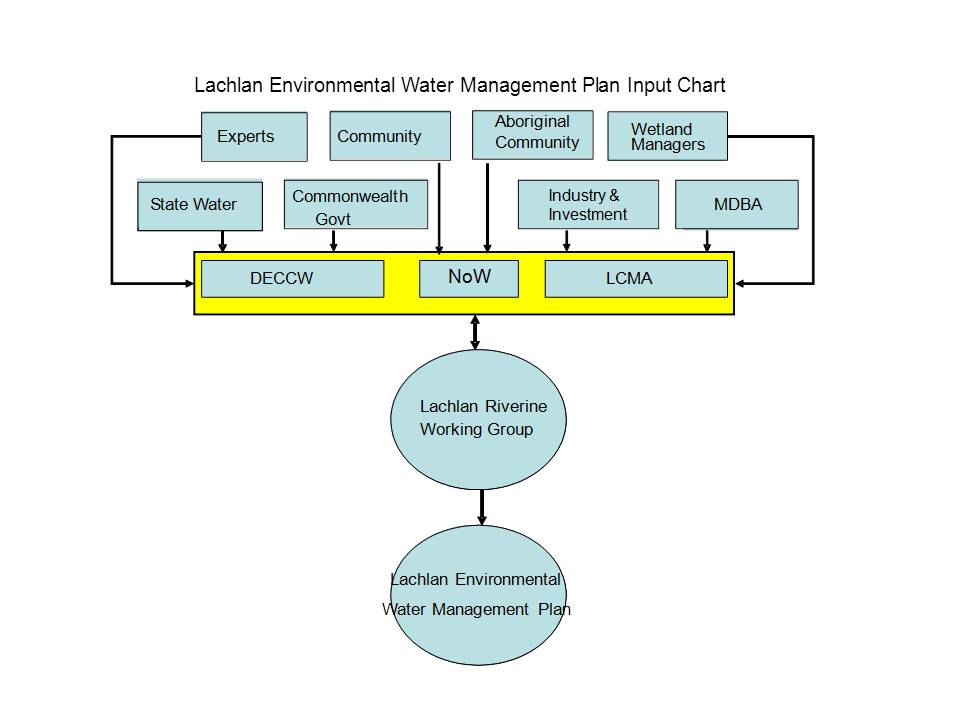
Summary of the Environmental Watering Plan
This website describes the Lachlan Environmental Water Management Plan. It details:
- the wetlands of the Lachlan River and their watering needs;
- the environmental watering decision-making process e.g. wetland selection, timing, volumes and frequency;
- the ecological objectives of environmental watering;
- the role of the Lachlan Riverine Working Group (LRWG) in delivering this plan; and
- the various rules, legislation and other institutional arrangements that must be considered.
Purpose, Targets and Framework
Purpose
The purpose of the Lachlan Environmental Water Management Plan (LEWMP) is to provide a strategic and coordinated approach to the maintenance and restoration of the region’s riverine areas, through the creation and implementation of an effective and well-informed management framework. This Plan will facilitate holistic decision making where the management of riverine assets, which includes wetlands, riparian areas, floodplains and river channels, is placed in context of the whole valley rather than on an individual basis. This Plan will also assist in performance monitoring of water management targets, to ensure that resource management efforts across the Lachlan are coordinated to deliver beneficial outcomes.
The LEWMP aims to:
- provide strategic directions in riverine management in the Lachlan Catchment;
- document the current knowledge for regional riverine assets;
- determine priority areas and activities for riverine investment and opportunities for achieving strategic objectives;
- provide a framework for the coordination of roles and responsibilities in environmental water delivery and management;
- provide a platform from which to engage the community;
- identify opportunities to integrate riverine management, particularly environmental water management, with other natural resource management issues (e.g. Lake Brewster Water Efficiency Program, Hillston Rural Floodplain Management Plan, Lachlan River Revival, Lake Cargelligo Environmental Management Plan; and,
- implement effective adaptive management through monitoring, evaluation, reporting and improvement (MERI).
Targets
The coordination and prioritisation of riverine management and associated environmental water delivery has the goal of, not only improving riverine ecological condition, but increasing resistance and resilience throughout the Lachlan system. This may be achieved through providing maintenance flows and improving river and floodplain connectivity. The goals of the LEWMP align with the NSW State Plan Resource Condition Targets relating to water and aquatic ecosystems which include:
- by 2015, there is an improvement in the condition of important wetlands and the extent of those wetlands are maintained; and,
- by 2015, there is an improvement in the condition of riverine ecosystems.
- The Catchment Action Plan, developed by the LCMA, addresses Resource Condition Targets through a number of Management Targets, the most relevant to the LEWMP includes:
- Management Target 14, By 2016, three surface water sources are being managed in accordance with the Water Sharing Plans;
- Management Target 15, By 2016, 10,000 ML of water is delivered more efficiently for the benefit of riverine ecosystems and for identified Aboriginal cultural practices;
- Management Target 20, By 2016, manage eight nationally significant wetlands and five regionally significant wetlands for improved biodiversity conservation; Lachlan Catchment Management Authority
- Management Target 21, By 2016, implement activities identified within existing and future floodplain management plans identified as providing environmental benefits; and,
- Management Target 22, By 2016, improve in-stream habitat at 80 sites.
However, it should be noted that the Lachlan Catchment Action Plan is currently under review, and targets relating to water management may change. These changes will need to be incorporated into the evolving LEWMP.
The objectives and actions not only relate to State Natural Resource Management planning, but also consider the Commonwealth Governments Caring for our Country outcome 3.3 by aiming to deliver actions which sustain the environmental values of an additional 25% of non-Ramsar priority inland high conservation value ecosystems including, as a priority, sites in the Murray-Darling Basin. The LEWMP also needs to consider the objectives and targets of the Murray-Darling Basin Authority’s Basin Plan and will need to comply with the Environmental Watering Plan (as per the Commonwealth Water Act 2007) and the regionally-based Water Resource Plans. While it is important that the LEWMP is consistent with the Commonwealth and NSW Governments strategic Natural Resource Management Plans, the LRWG focus will remain an ecosystem approach, to address all issues relating to restoring riverine health.
The effectiveness of any environmental water management plan is limited by other factors such as land management, climate, current knowledge and water delivery options. The effectiveness of the LEWMP will depend on continued learning and employing best-practice adaptive management.
Framework
The development of the LEWMP requires input and comment from a number of organisations and stakeholders as illustrated below. While the Lachlan Riverine Working Group will be responsible for the overall formulation of the LEWMP, the NSW Office of Environment and Heritage, the NSW Office of Water (NoW) and Lachlan CMA (LCMA) will be major contributors. Other State and Commonwealth agencies will provide input to components of the Plan, with the community and wetland managers providing further comment and assistance as part of the wetland asset assessment process and direction-setting.

